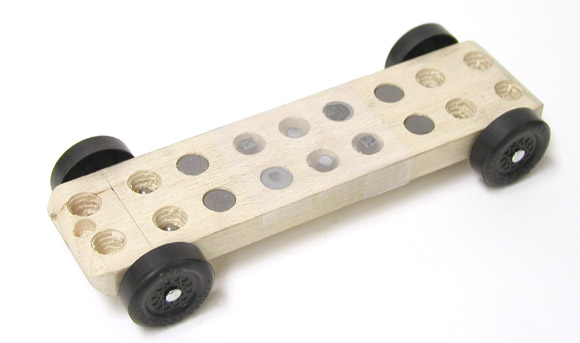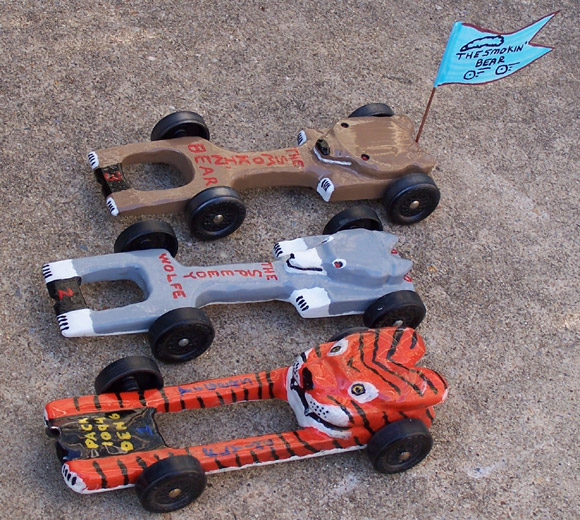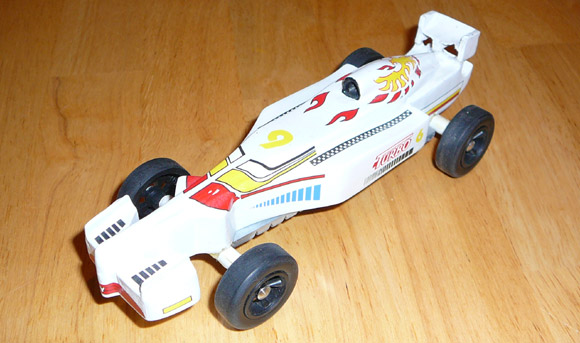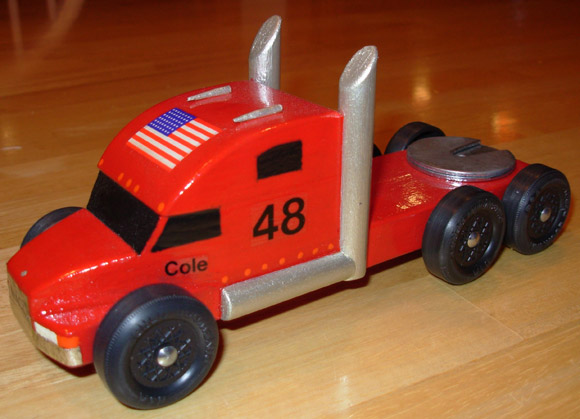– Feature Article – Effect of Wheel Weight on Performance
– Pinewood Derby Car Showcase
– Memory – Mrs. Bubba’s Do’s and Don’ts
– Q&A
Effect of Wheel Weight on Performance
One of the major changes to pinewood derby racing during the past year was the wide-spread availability of light-weight speed wheels. For BSA, wheels ranging from 3.3 to 1.0 grams were offered by various vendors including Maximum Velocity.
But what is the performance benefit of lighter weight wheels? To help answer this question, I ran an experiment comparing 1.0, 1.9, and 2.9 gram wheels, the results of which are documented in this article.
However, first I want to position these results. This experiment shows the general effect of wheel weight on performance, and can be used to estimate the benefit of weight reduction. On the other hand, the results cannot be used to absolutely state the benefit of using any given 1.0 gram wheel versus any given heavier wheel. Many wheel-related factors affect speed including the quality of the raw wheel, the machining method, the weight-reduction technique, and the skill/accuracy of the lathe and lathe operator. Therefore, wheel weight is only one factor that should be considered when selecting a set of wheels.
Experiment Equipment
The experiment used the following equipment:
- Pinewood Wizard body – This body allows the weight to be readily changed without affecting the balance point.
- Pro-Ultralite Speed Wheels from DerbyWorx – These official BSA wheels weigh 1.0 gram, and are machined with a high level of accuracy
- Speed Axles from Maximum Velocity
- Eight, 1-1/8 x 7/8 x 1/8 O-rings – One or two of these rings were inserted into each wheels to increase the weight
Car Body
The Pinewood Wizard body was set up to weigh 5.0 ounces with the wheels and axles (no o-rings). Sufficient tungsten beads to account for eight o-rings were included as part of the weight. The car was centered weighted, and all four wheels were running on the track (see Figure 1).
Figure 1 – Wizard Body Weighted for 1.0 Gram Wheels
Wheels
The O-Rings were cut, so that they could be inserted into the wheel interior without removing the wheels from the car (see Figure 2). This technique eliminated experimental variance that would have been introduced if the wheels were removed and re-installed during the experiment. Wheel weight was as follows:
- No O-Rings – 1.0 gram
- 1 O-Ring – 1.9 grams
- 2 O-Rings – 2.9 grams

Axles
The axles were lightly polished and then lubed with Krytox 100. The wheels/axles were installed on the car, and the alignment was checked to verify that the car rolled virtually straight.
Track
A 32 foot aluminum Freedom Track was used with a Judge Timer. For each run the car was staged in the left lane.
Experiment Procedure
The car was first run twice for lube break-in. Then, to minimize lube variance, the tests were made from low to high wheel weight, and then again from high to low wheel weight. The sequence was as follows:
- Three heats were run with the 1.0 gram wheel weight. An o-ring was then added to each wheel, and tungsten beads were removed symmetrically to maintain the 5.0 ounce weight and center balance point.
- Three heats were run with the 1.9 gram wheel weight. A second o-ring was then added to each wheel, and the weight adjusted to 5.0 ounces.
- Six heats were run with the 2.9 gram wheel weight. One o-ring was removed from each wheel, and the weight was adjusted.
- Three additional heats were run with the 1.9 gram wheel weight. The last o-ring was removed, and the weight was adjusted.
- Three heats were run with the 1.0 gram wheel weight.
Experiment Results
The following chart shows the results of the test. The red plot shows the results of the raw data, and the blue plot shows the results with the high and low run removed for each weight.
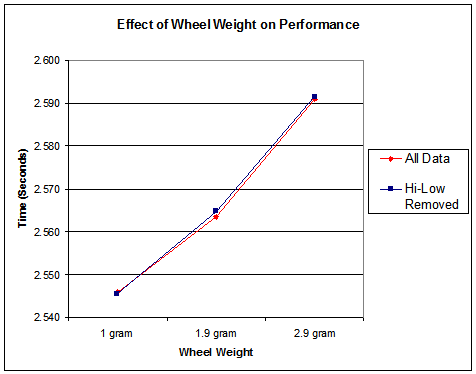
Conclusions
When racing on a 32 foot track, wheel weight has a significant negative impact on performance. Running with the lightest possible wheels (while still maintaining structural integrity) will offer the best performance possibilities.
It is possible that the results of this experiment would vary on a longer track, however, it is my belief that lighter weight wheels will provide better performance on all tracks, with the possible exception of extremely long ‘monster’ tracks.
Pinewood Derby Car Showcase
Cub Scout Theme Cars: Bill & Zachary Williams
Attached is a picture of our recent pinewood derby cars that I thought you may want to share with the other subscribers. I included the car from this year, and the cars from the past two years to show our series of Cub Scout theme cars. When my son was a Tiger Cub, we made the “Flying Tiger”, and when he was a Wolf Cub, we made the “Speedy Wolf”. This year as a Bear Cub, we made the “Smokin’ Bear”. His bear car won first in den and first in pack for speed. He also won the appearance award for Best Scout Theme.
By the way, for the first time this year we used the new Tungsten Plates. This is a GREAT product!!! We used 6 of them (3 oz. total) under the rear section of the car. Three of them were recessed into the bottom of the car as to make them flush with the bottom of the car. The other three were mounted on top of these and hung below the bottom of the car. We still have plenty of clearance under the car. Our body was very light, about one ounce, and very light in the front of the car. These tungsten plates added an ENORMOUS amount of stability to the car. We only had to add about 2 tungsten cubes more weight to get to five ounces. This is one of the best new products I have seen come on the market.
Formula One: Chris & Jacob Holan
My son Jacob and I worked on this car for last year’s pinewood derby. He took one of his matchbox cars and asked me to put the design on the wood. We used a Dremel Tool to help with the fine details. He painted and put on the decals himself. The car took first place in design and would have done better during the race, but dad forgot the graphite for the wheels.
Mack Truck: Roger & Cole VandePoel
Attached is the Mack truck that my son Cole and I built and raced in this year’s annual Pack 48 Cub Scout pinewood derby. The truck has six wheels, the center two are raised slightly, such as not to touch the track and slow the truck down. We constructed the top of the cab from material that we removed from the rear. On the rear of the truck is it’s name “Easy Mack” named after Cole’s favorite lunch snack.
Pinewood Derby Memory
Mrs. Bubba’s Do’s and Don’ts
Do – put a towel down to catch paint / sawdust / graphite when using the Dining Room table as a base of operations.
Don’t – make it a “good” towel (you know the ones).
Do – use any smelly products (Paint, certain adhesives) outside so as not to “funk up” the house.
Don’t – bring wet cars back into the kitchen to dry. Especially don’t suspend them from the kitchen cabinet handles with a piece of wire.
Do – find a spot in the basement / garage for your workshop equipment.
Don’t – hide out there for hours on end with the door closed so that you aren’t able to hear her when she calls for you.
Do – build your wife a sweet Open Class car to her specifications.
Don’t – beat her car yearly in the Open Class.
Do – clean up and put everything away when you are done.
Don’t – clutter up the living room with derby kits, priority mail shipping boxes from Maximum Velocity, printouts of DerbyTalk posts, etc. Especially don’t clutter up the fireplace mantle with “in process” cars that you’re leaving there for inspiration.
Do – share with her stories about heartwarming derby triumphs (e.g., she appreciated “MOM Derby’s” success this year and thinks all you guys are sweet for helping her and her boy out).
Don’t – share with her stories about technical derby triumphs (e.g., new tools – she is not warm towards arcane derby details and/or subtle sales pitches).
Do – allow your younger ones to watch “Down and Derby” – mine think it’s hilarious.
Don’t – allow them to badger their mother about watching it again and again.
Do – clean up any used strips of sandpaper after polishing axles in the drill press.
Don’t – use her pizza scissors (or any other good scissors for that matter) to cut the aforementioned strips of sandpaper.
Rick Sanner (Go-Bubba-Go on the DerbyTalk Forum)
Originally published on the DerbyTalk Forum
Used by Permission
Q&A
I have run out of fresh questions, so these are recycled and updated from Volume 1 of the Pinewood Derby Times published in the 2001-02 season.
I was just at my son’s first race and noticed the other guys really examining the placement of their cars on the track. Does exact placement make a great difference?
In a close race the car position at the starting line can make a difference. The goal is for the car to roll as far as possible before bumping the guide rail. So it is best to center the car over the guide rail and point it as straight as possible down the track.
Some people pull the wheels all the way outward towards the axle heads. The idea is to minimize the wheel hub rubbing on the side of the car, which generally is worse than rubbing on the axle head.
I know that everyone tells you that the maximum weight of a car is five ounces. But at our pack weigh-in the scale measured in grams and it was confusing. Why would they do this? Is grams or ounces the official unit of measurement for BSA?
The rules with the BSA kit specify five ounces, so that is the official maximum weight and official units. Most race leaders use a postal scale that measures in ounces. But some race leaders use a scientific scale that measures in grams. This was evidently the situation at your race.
Either type of scale can be used, and the type of scale used is oftentimes simply the type that is available to the race leader. However, there is a slight advantage to the scientific scale as it usually has greater accuracy. Postal scales typically measure to the nearest 0.1 ounce (2.835 grams), while scientific scales measure to the nearest fraction of a gram.
I suggest that if cars will be weighed in grams, then that fact should be clearly stated in the local rules. The rules should also state the maximum weight in grams and the conversion factor from ounces to grams.
By the way, there is sometimes confusion as to the correct conversion factor as there are two types of ounces, avoirdupois and apothecary (troy). In the United States we use the avoirdupois ounce for weighing most goods. Conversion from ounces to grams is accomplished by multiplying the number of ounces by 28.35. Thus, a five-ounce car would weigh 141.75 grams.
Be aware – if you have a scale used for weighing pharmaceuticals, it will likely weigh in troy ounces; a five ounce car will not weigh five ounces on a pharmaceutical scale! I have had a few calls from customers insisting that our 5 ounce weight was way off. After some discussion, we discovered that the scale being used was a pharmaceutical scale and was weighing in troy ounces. Note that the conversion from troy ounces to grams is 31.10.
Recently my son had the opportunity to compete in his first pinewood derby. At the weigh-in, his Cub Scout troop provided Play-Doh to add to any cars that needed extra weight. One child added his Play-Doh to the front of the car, and on almost every run down the track the weight came off when it hit the stopping block. An official replaced the Play-Doh after each heat. Finally, in an attempt to keep it from coming off, the official changed the position of the Play-Doh from the front to the rear of the car, and gave it a more aerodynamic shape. My son lost the den championship to this car by a very small margin. Is it common practice to replace weight after it falls off? What about changing the position and shape of the weight after it has already run a race?
Before I answer your question, let me ask you one. What do your local rules say about attaching objects to the car, replacing lost parts, and making modifications after the weigh-in? If your rules address these issues, and the official violated them, then there is some room for discussion regarding the outcome of the race. However, if your rules do not address these issues then consider working with the pinewood derby committee to update the rules for next year. Here are some suggestions.
Attachment of Weights
Most rules state that all objects must be firmly attached to the car (with screws, permanent glue, etc.). This rule virtually eliminates occurrences such as the one you experienced. Clearly, placing Play-Doh on the car would violate this rule. Play-Doh might be acceptable as weight if it were firmly embedded in a hole or pocket in the car. One reader states that a small groove can be created in the bottom of the car and filled with clay. The clay can then be adjusted at the weigh-in. Clay is likely superior to Play-Doh for this application as clay takes longer to dry out, and does not shrink as much.
Parts Falling Off the Car
Generally, parts falling off a car may only be replaced if they are critical (i.e., wheels and axles). In our race if accessories or weight fall off, we do not replace them. But because of rule one above, this rarely happens.
Moving the Weight After the Weigh-in
Every set of rules I have ever seen prohibits car modifications after the weigh-in. Moving weight from the front to the back of the car is clearly a modification as it affects performance.
Want Answers?
Do you have a pinewood derby-related question? If so, e-mail us your question.We answer all questions by e-mail, but not every question will appear in the Q&A section of the newsletter.
Back Issues
Are you a new subscriber, or have you missed some of the previous newsletters? Don’t miss out; all of the issues for Volume 5 through Volume 17 are posted on our web site.
Newsletter Contributions
We welcome your contributions. If you would like to contribute an article, a web site review, a speed tip, or a pinewood derby memory, please e-mail us.
Subscription Information
The Pinewood Derby Times is a free e-newsletter focused on pinewood derby racing. It is published biweekly from October through March.
If you haven’t already done so, please forward this issue to your pinewood derby friends. But please don’t subscribe your friends. Let them decide for themselves. Thanks.
If this newsletter was forwarded to you, why not subscribe to receive this newsletter. There is no cost, and your e-mail address is safe, as we never sell or share our distribution list.
To subscribe, send a blank e-mail to
[email protected]
You will receive a confirmation e-mail. Reply to the confirmation e-mail and you will start receiving the Pinewood Derby Times with the next issue.
Randy Davis, Editor, Pinewood Derby Times
E-Mail: [email protected]
(C)2018, Maximum Velocity, Inc. All rights reserved. Please do not reprint or place this newsletter on your web site without explicit permission. However, if you like this newsletter we grant permission, and encourage you to e-mail it to a friend.
Maximum Velocity disclaims any personal loss or liability caused by utilization of any information presented in this newsletter.
The Pinewood Derby Times is not specific to, and is not affiliated with the Boy Scouts of America, YMCA, Awana, or any other organization.
(R)Maximum Velocity is a registered trademark of Maximum Velocity, Inc.
(R)Pinewood Derby is a registered trademarks of the Boys Scouts of America.
(R)Awana is a registered trademark of Awana Clubs International.
All other names are trademarks of their respective owners.

